计算机网络自顶向下答案第六章中文版
- 格式:doc
- 大小:77.50 KB
- 文档页数:2
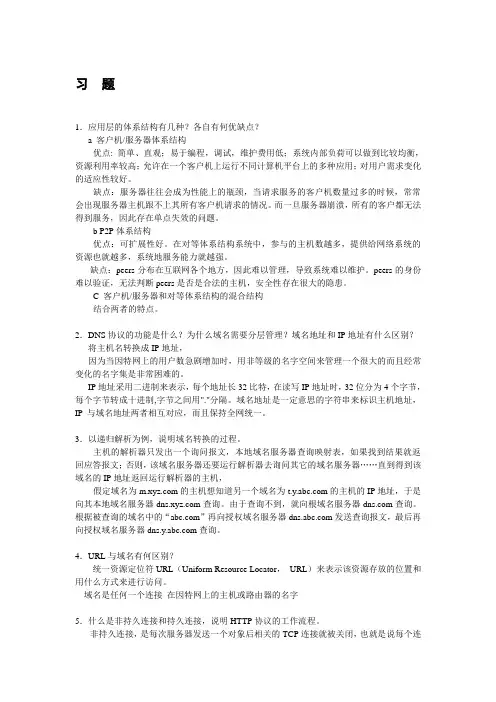
习题1.应用层的体系结构有几种?各自有何优缺点?a 客户机/服务器体系结构优点: 简单、直观;易于编程,调试,维护费用低;系统内部负荷可以做到比较均衡,资源利用率较高;允许在一个客户机上运行不同计算机平台上的多种应用;对用户需求变化的适应性较好。
缺点:服务器往往会成为性能上的瓶颈,当请求服务的客户机数量过多的时候,常常会出现服务器主机跟不上其所有客户机请求的情况。
而一旦服务器崩溃,所有的客户都无法得到服务,因此存在单点失效的问题。
b P2P体系结构优点:可扩展性好。
在对等体系结构系统中,参与的主机数越多,提供给网络系统的资源也就越多,系统地服务能力就越强。
缺点:peers分布在互联网各个地方,因此难以管理,导致系统难以维护。
peers的身份难以验证,无法判断peers是否是合法的主机,安全性存在很大的隐患。
C 客户机/服务器和对等体系结构的混合结构结合两者的特点。
2.DNS协议的功能是什么?为什么域名需要分层管理?域名地址和IP地址有什么区别?将主机名转换成IP地址,因为当因特网上的用户数急剧增加时,用非等级的名字空间来管理一个很大的而且经常变化的名字集是非常困难的。
IP地址采用二进制来表示,每个地址长32比特,在读写IP地址时,32位分为4个字节,每个字节转成十进制,字节之间用"."分隔。
域名地址是一定意思的字符串来标识主机地址,IP 与域名地址两者相互对应,而且保持全网统一。
3.以递归解析为例,说明域名转换的过程。
主机的解析器只发出一个询问报文,本地域名服务器查询映射表,如果找到结果就返回应答报文;否则,该域名服务器还要运行解析器去询问其它的域名服务器……直到得到该域名的IP地址返回运行解析器的主机,假定域名为的主机想知道另一个域名为的主机的IP地址,于是向其本地域名服务器查询。
由于查询不到,就向根域名服务器查询。
根据被查询的域名中的“”再向授权域名服务器发送查询报文,最后再向授权域名服务器查询。
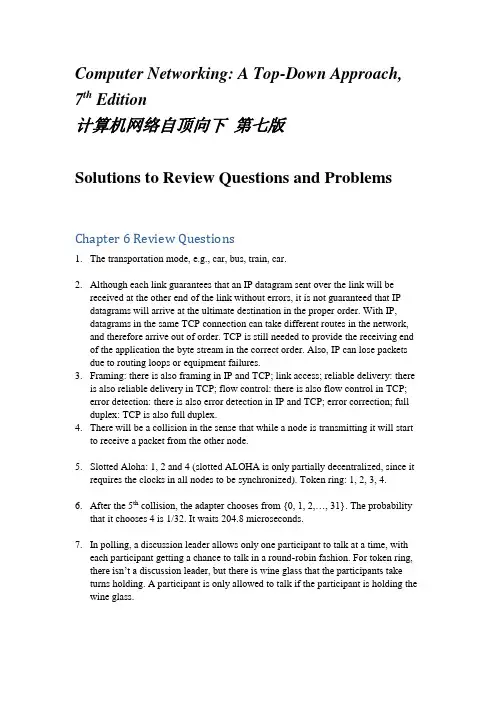
Computer Networking: A Top-Down Approach, 7th Edition计算机网络自顶向下第七版Solutions to Review Questions and ProblemsChapter 6 Review Questions1.The transportation mode, e.g., car, bus, train, car.2.Although each link guarantees that an IP datagram sent over the link will bereceived at the other end of the link without errors, it is not guaranteed that IP datagrams will arrive at the ultimate destination in the proper order. With IP,datagrams in the same TCP connection can take different routes in the network, and therefore arrive out of order. TCP is still needed to provide the receiving end of the application the byte stream in the correct order. Also, IP can lose packets due to routing loops or equipment failures.3.Framing: there is also framing in IP and TCP; link access; reliable delivery: thereis also reliable delivery in TCP; flow control: there is also flow control in TCP;error detection: there is also error detection in IP and TCP; error correction; full duplex: TCP is also full duplex.4.There will be a collision in the sense that while a node is transmitting it will startto receive a packet from the other node.5.Slotted Aloha: 1, 2 and 4 (slotted ALOHA is only partially decentralized, since itrequires the clocks in all nodes to be synchronized). Token ring: 1, 2, 3, 4.6.After the 5th collision, the adapter chooses from {0, 1, 2,…, 31}. The probabilitythat it chooses 4 is 1/32. It waits 204.8 microseconds.7.In polling, a discussion leader allows only one participant to talk at a time, witheach participant getting a chance to talk in a round-robin fashion. For token ring, there isn’t a discussion leader, but there is wine glass that the participants take turns holding. A participant is only allowed to talk if the participant is holding the wine glass.8.When a node transmits a frame, the node has to wait for the frame to propagatearound the entire ring before the node can release the token. Thus, if L/R is small as compared to t prop, then the protocol will be inefficient.9.248 MAC addresses; 232 IPv4 addresses; 2128 IPv6 addresses.10.C’s adapter will process the frames, but the adapter will not pass the datagrams upthe protocol stack. If the LAN broadcast address is used, then C’s adapter will both process the frames and pass the datagrams up the protocol stack.11.An ARP query is sent in a broadcast frame because the querying host does notwhich adapter address corresponds to the IP address in question. For the response, the sending node knows the adapter address to which the response should be sent, so there is no need to send a broadcast frame (which would have to be processed by all the other nodes on the LAN).12.No it is not possible. Each LAN has its own distinct set of adapters attached to it,with each adapter having a unique LAN address.13.The three Ethernet technologies have identical frame structures.14.2 (the internal subnet and the external internet)15.In 802.1Q there is a 12- bit VLAN identifier. Thus 212 = 4,096 VLANs can besupported.16.We can string the N switches together. The first and last switch would use oneport for trunking; the middle N-2 switches would use two ports. So the totalnumber of ports is 2+ 2(N-2) = 2N-2 ports.Chapter 6 ProblemsProblem 11 1 1 0 10 1 1 0 01 0 0 1 01 1 0 1 11 1 0 0 0Problem 2Suppose we begin with the initial two-dimensional parity matrix:0 0 0 01 1 1 10 1 0 11 0 1 0With a bit error in row 2, column 3, the parity of row 2 and column 3 is now wrong in the matrix below:0 0 0 01 1 0 10 1 0 11 0 1 0Now suppose there is a bit error in row 2, column 2 and column 3. The parity of row 2 is now correct! The parity of columns 2 and 3 is wrong, but we can't detect in which rows the error occurred!0 0 0 01 0 0 10 1 0 11 0 1 0The above example shows that a double bit error can be detected (if not corrected).Problem 301001100 01101001+ 01101110 01101011------------------------------10111010 11010100+ 00100000 01001100------------------------------11011011 00100000+ 01100001 01111001-----------------------------00111100 10011010 (overflow, then wrap around)+ 01100101 01110010------------------------------10100010 00001100The one's complement of the sum is 01011101 11110011Problem 4a)To compute the Internet checksum, we add up the values at 16-bit quantities:00000001 0000001000000011 0000010000000101 0000011000000111 0000100000001001 00001010-------------------------00011001 00011110The one's complement of the sum is 11100110 11100001.b)To compute the Internet checksum, we add up the values at 16-bit quantities: 01000010 0100001101000100 0100010101000110 0100011101001000 0100100101001010 01001011-------------------------10011111 10100100The one's complement of the sum is 01100000 01011011c)To compute the Internet checksum, we add up the values at 16-bit quantities: 01100010 0110001101100100 0110010101100110 0110011101101000 0110100101101010 01101011-------------------------00000000 00000101The one's complement of the sum is 11111111 11111010.Problem 5If we divide 10011 into 1010101010 0000, we get 1011011100, with a remainder of R=0100. Note that, G=10011 is CRC-4-ITU standard.Problem 6a) we get 1000110000, with a remainder of R=0000.b) we get 010*******, with a remainder of R=1111.c) we get 1011010111, with a remainder of R=1001.Problem 7a) Without loss of generality, suppose ith bit is flipped, where 0<= i <= d+r-1 and assume that the least significant bit is 0th bit.A single bit error means that the received data is K=D*2r XOR R + 2i. It is clear that if we divide K by G, then the reminder is not zero. In general, if G contains at least two 1’s, then a single bit error can always be detected.b) The key insight here is that G can be divided by 11 (binary number), but any number of odd-number of 1’s cannot be divided by 11. Thus, a sequence (not necessarily contiguous) of odd-number bit errors cannot be divided by 11, thus it cannot be divided by G.Problem 8a)1)1()(--=N p Np p E21)1)(1()1()('------=N N p N Np p N p E))1()1(()1(2----=-N p p p N NN p p E 1*0)('=⇒=b)N N N N N N p E N N N 11)11()11()11(1*)(11--=-=-=-- 1)11(lim =-∞→N N e N N N 1)11(lim =-∞→ Thuse p E N 1*)(lim =∞→Problem 9)1(2)1()(--=N p Np p E)3(2)2(2)1)(1(2)1()('------=N N p N Np p N p E))1(2)1(()1()3(2----=-N p p p N N121*0)('-=⇒=N p p E)1(2)1211(12*)(----=N N N N p E e e p E N 21121*)(lim =⋅=∞→Problem 10a) A’s average throughput is given by pA(1-pB).Total efficiency is pA(1-pB) + pB(1-pA).b) A’s throughput is pA(1-pB)=2pB(1-pB)= 2pB- 2(pB)2.B’s throughput is pB(1-pA)=pB(1-2pB)= pB- 2(pB)2.Clearly, A’s throughput is not twice as large as B’s.In order to make pA(1-pB)= 2 pB(1-pA), we need that pA= 2 – (pA / pB).c)A’s throughput is 2p(1-p)N-1, and any other node has throughput p(1-p)N-2(1-2p).Problem 11a)(1 – p(A))4 p(A)where, p(A) = probability that A succeeds in a slotp(A) = p(A transmits and B does not and C does not and D does not)= p(A transmits) p(B does not transmit) p(C does not transmit) p(D does not transmit)= p(1 – p) (1 – p)(1-p) = p(1 – p)3Hence, p(A succeeds for first time in slot 5)= (1 – p(A))4 p(A) = (1 – p(1 – p)3)4 p(1 – p)3b)p(A succeeds in slot 4) = p(1-p)3p(B succeeds in slot 4) = p(1-p)3p(C succeeds in slot 4) = p(1-p)3p(D succeeds in slot 4) = p(1-p)3p(either A or B or C or D succeeds in slot 4) = 4 p(1-p)3(because these events are mutually exclusive)c)p(some node succeeds in a slot) = 4 p(1-p)3p(no node succeeds in a slot) = 1 - 4 p(1-p)3Hence, p(first success occurs in slot 3) = p(no node succeeds in first 2 slots) p(some node succeeds in 3rd slot) = (1 - 4 p(1-p)3)2 4 p(1-p)3d)efficiency = p(success in a slot) =4 p(1-p)3Problem 12Problem 13The length of a polling round is)/(poll d R Q N +.The number of bits transmitted in a polling round is NQ . The maximum throughput therefore isQR d R d R Q N NQ poll poll +=+1)/( Problem 14a), b) See figure below.c)1. Forwarding table in E determines that the datagram should be routed to interface 192.168.3.002.2. The adapter in E creates and Ethernet packet with Ethernet destination address 88-88-88-88-88-88.3. Router 2 receives the packet and extracts the datagram. The forwarding table in this router indicates that the datagram is to be routed to 198.162.2.002.4.Router 2 then sends the Ethernet packet with the destination address of 33-33-33-33-33-33 and source address of 55-55-55-55-55-55 via its interface with IP address of 198.162.2.003.5.The process continues until the packet has reached Host B.a)ARP in E must now determine the MAC address of 198.162.3.002. Host E sendsout an ARP query packet within a broadcast Ethernet frame. Router 2 receives the query packet and sends to Host E an ARP response packet. This ARP response packet is carried by an Ethernet frame with Ethernet destination address 77-77-77-77-77-77.Problem 15a)No. E can check the subnet prefix of Host F’s IP address, and then learn that F ison the same LAN. Thus, E will not send the packet to the default router R1. Ethernet frame from E to F:Source IP = E’s IP addressDestination IP = F’s IP addressSource MAC = E’s MAC addressDestination MAC = F’s MAC addressb)No, because they are not on the same LAN. E can find this out by checking B’s IPaddress.Ethernet frame from E to R1:Source IP = E’s IP addressDestination IP = B’s IP addressSource MAC = E’s MAC addressDestination MAC = The MAC address of R1’s interface connecting to Subnet 3.c)Switch S1 will broadcast the Ethernet frame via both its interfaces as the receivedARP frame’s destination address is a broadcast address. And it learns that Aresides on Subnet 1 which is connected to S1 at the interface connecting to Subnet1. And, S1 will update its forwarding table to include an entry for Host A.Yes, router R1 also receives this ARP request message, but R1 won’t forward the message to Subnet 3.B won’t send ARP query message asking for A’s MAC address, as this address can be obtained from A’s query message.Once switch S1 receives B’s response message, it will add an entry for host B in its forwarding table, and then drop the received frame as destination host A is on the same interface as host B (i.e., A and B are on the same LAN segment).Lets call the switch between subnets 2 and 3 S2. That is, router R1 between subnets 2 and 3 is now replaced with switch S2.a) No. E can check the subnet prefix of Host F’s IP address, and then learn that F is on the same LAN segment. Thus, E will not send the packet to S2. Ethernet frame from E to F: Source IP = E’s IP address Destination IP = F’s IP address Source MAC = E’s MAC addressDestination MAC = F’s MAC addressb) Yes, because E would like to find B’s MAC address. In this case, E will send an ARP query packet with destination MAC address being the broadcast address. This query packet will be re-broadcast by switch 1, and eventually received by Host B. Ethernet frame from E to S2: Source IP = E’s IP address Destination IP = B’s IP address Source MAC = E’s MAC addressDestination MAC = broadcast MAC address: FF-FF-FF-FF-FF-FF.c) Switch S1 will broadcast the Ethernet frame via both its interfaces as the received ARP frame’s destination address is a broadcast address. And it learns that Aresides on Subnet 1 which is connected to S1 at the interface connecting to Subnet 1. And, S1 will update its forwarding table to include an entry for Host A.Yes, router S2 also receives this ARP request message, and S2 will broadcast this query packet to all its interfaces.B won’t send ARP query message asking for A’s MAC address, as this address can be obtained from A’s query message.Once switc h S1 receives B’s response message, it will add an entry for host B in its forwarding table, and then drop the received frame as destination host A is on the same interface as host B (i.e., A and B are on the same LAN segment).Problem 17Wait for 51,200 bit times. For 10 Mbps, this wait is12.51010102.5163=⨯⨯bps bitsmsecFor 100 Mbps, the wait is 512 μsec.At 0=t A transmits. At 576=t , A would finish transmitting. In the worst case, B begins transmitting at time t=324, which is the time right before the first bit of A’s frame arrives at B. At time t=324+325=649 B 's first bit arrives at A . Because 649> 576, A finishes transmitting before it detects that B has transmitted. So A incorrectly thinks that its frame was successfully transmitted without a collision.Problem 19Because A 's retransmission reaches B before B 's scheduled retransmission time (805+96), B refrains from transmitting while A retransmits. Thus A and B do not collide. Thus the factor 512 appearing in the exponential backoff algorithm is sufficiently large.Problem 20a) Let Y be a random variable denoting the number of slots until a success:1)1()(--==m m Y P ββ,where β is the probability of a success.This is a geometric distribution, which has mean β/1. The number of consecutive wasted slots is 1-=Y X thatββ-=-==11][][Y E X E x1)1(--=N p Np β11)1()1(1-----=N N p Np p Np xefficiency11)1()1(1-----+=+=N N p Np p Np k kxk kb)Maximizing efficiency is equivalent to minimizing x , which is equivalent tomaximizing β. We know from the text that β is maximized at Np 1=.c)efficiency 11)11()11(1-----+=N N NN k k∞→N lim efficiency 1/1/11-+=-+=e k kee k kd) Clearly, 1-+e k kapproaches 1 as ∞→k .Problem 21i) from A to left router: Source MAC address: 00-00-00-00-00-00Destination MAC address: 22-22-22-22-22-22Source IP: 111.111.111.001Destination IP: 133.333.333.003ii) from the left router to the right router: Source MAC address: 33-33-33-33-33-33Destination MAC address: 55-55-55-55-55-55Source IP: 111.111.111.001Destination IP: 133.333.333.003iii) from the right router to F: Source MAC address: 88-88-88-88-88-88Destination MAC address: 99-99-99-99-99-99Source IP: 111.111.111.001Destination IP: 133.333.333.003Problem 22i) from A to switch: Source MAC address: 00-00-00-00-00-00Destination MAC address: 55-55-55-55-55-55Source IP: 111.111.111.001Destination IP: 133.333.333.003ii) from switch to right router: Source MAC address: 00-00-00-00-00-00Destination MAC address: 55-55-55-55-55-55Source IP: 111.111.111.001Destination IP: 133.333.333.003iii) from right router to F: Source MAC address: 88-88-88-88-88-88Destination MAC address: 99-99-99-99-99-99Source IP: 111.111.111.001Destination IP: 133.333.333.003111.111.111.00311-11-11-11-11-11122.222.222.00466-66-66-66-66Problem 23If all the 11=9+2 nodes send out data at the maximum possible rate of 100 Mbps, a total aggregate throughput of 11*100 = 1100 Mbps is possible.Problem 24Each departmental hub is a single collision domain that can have a maximum throughput of 100 Mbps. The links connecting the web server and the mail server has a maximum throughput of 100 Mbps. Hence, if the three collision domains and the web server and mail server send out data at their maximum possible rates of 100 Mbps each, a maximum total aggregate throughput of 500 Mbps can be achieved among the 11 end systems.Problem 25All of the 11 end systems will lie in the same collision domain. In this case, the maximum total aggregate throughput of 100 Mbps is possible among the 11 end sytems. Problem 26Problem 27a) The time required to fill 8⋅L bits is.sec 16sec 1012883m LL =⨯⋅b) For ,500,1=L the packetization delay is.sec 75.93sec 161500m m =For ,50=L the packetization delay is.sec 125.3sec 1650m m =c) Store-and-forward delay RL 408+⋅=For 500,1=L , the delay issec 4.19sec 1062240815006μ≈⨯+⋅For ,50=L store-and-forward delay sec 1μ<.d) Store-and-forward delay is small for both cases for typical link speeds. However, packetization delay for 1500=L is too large for real-time voice applications.Problem 28The IP addresses for those three computers (from left to right) in EE department are: 111.111.1.1, 111.111.1.2, 111.111.1.3. The subnet mask is 111.111.1/24.The IP addresses for those three computers (from left to right) in CS department are: 111.111.2.1, 111.111.2.2, 111.111.2.3. The subnet mask is 111.111.2/24.The router’s interface card that connects to port 1 can be configured to contain two sub-interface IP addresses: 111.111.1.0 and 111.111.2.0. The first one is for the subnet of EE department, and the second one is for the subnet of CS department. Each IP address is associated with a VLAN ID. Suppose 111.111.1.0 is associated with VLAN 11, and 111.111.2.0 is associated with VLAN 12. This means that each frame that comes from subnet 111.111.1/24 will be added an 802.1q tag with VLAN ID 11, and each frame that comes from 111.111.2/24 will be added an 802.1q tag with VLAN ID 12. Suppose that host A in EE department with IP address 111.111.1.1 would like to send an IP datagram to host B (111.111.2.1) in CS department. Host A first encapsulates the IP datagram (destined to 111.111.2.1) into a frame with a destination MAC address equal to the MAC address of the router’s interface card that connects to port 1 of the switch. Once the router receives the frame, then it passes it up to IP layer, which decides that the IP datagram should be forwarded to subnet 111.111.2/24 via sub-interface 111.111.2.0. Then the router encapsulates the IP datagram into a frame and sends it to port 1. Note that this frame has an 802.1q tag VLAN ID 12. Once the switch receives the frame port 1, it knows that this frame is destined to VLAN with ID 12, so the switch will send the frame to Host B which is in CS department. Once Host B receives this frame, it will remove the 802.1q tag.Problem 30(The following description is short, but contains all major key steps and key protocols involved.)Your computer first uses DHCP to obtain an IP address. You computer first creates a special IP datagram destined to 255.255.255.255 in the DHCP server discovery step, and puts it in a Ethernet frame and broadcast it in the Ethernet. Then following the steps in the DHCP protocol, you computer is able to get an IP address with a given lease time.A DHCP server on the Ethernet also gives your computer a list of IP addresses of first-hop routers, the subnet mask of the subnet where your computer resides, and the addresses of local DNS servers (if they exist).Since your computer’s ARP cache is initially empty, your computer will use ARP protocol to get the MAC addresses of the first-hop router and the local DNS server.Your computer first will get the IP address of the Web page you would like to download. If the local DNS server does not have the IP address, then your computer will use DNS protocol to find the IP address of the Web page.Once your computer has the IP address of the Web page, then it will send out the HTTP request via the first-hop router if the Web page does not reside in a local Web server. The HTTP request message will be segmented and encapsulated into TCP packets, and then further encapsulated into IP packets, and finally encapsulated into Ethernet frames. Your computer sends the Ethernet frames destined to the first-hop router. Once the router receives the frames, it passes them up into IP layer, checks its routing table, and then sends the packets to the right interface out of all of its interfaces.Then your IP packets will be routed through the Internet until they reach the Web server. The server hosting the Web page will send back the Web page to your computer via HTTP response messages. Those messages will be encapsulated into TCP packets and then further into IP packets. Those IP packets follow IP routes and finally reach yourfirst-hop router, and then the router will forward those IP packets to your computer by encapsulating them into Ethernet frames.Problem 32a) Each flow evenly shares a link’s capacity with other flows traversing that link, then the 80 flows crossing the B to access-router 10 Gbps links (as well as the access router to border router links) will each only receive 10 Gbps / 80 = 125 Mbpsb) In Topology of Figure 5.31, there are four distinct paths between the first and third tier-2 switches, together providing 40 Gbps for the traffic from racks 1-4 to racks 9-12. Similarly, there are four links between second and fourth tier-2 switches, together providing 40 Gbps for the traffic from racks 5-8 to 13-16. Thus the total aggregate bandwidth is 80 Gbps, and the value per flow rate is 1 Gbps.c) Now 20 flows will need to share each 1 Gbps bandwidth between pairs of TOR switches. So the host-to-host bit rate will be 0.5 Gbps.Problem 33a)Both email and video application uses the fourth rack for 0.1 percent of the time.b)Probability that both applications need fourth rack is 0.001*0.001 = 10-6.c)Suppose the first three racks are for video, the next rack is a shared rack for bothvideo and email, and the next three racks are for email. Let's assume that thefourth rack has all the data and software needed for both the email and video applications. With the topology of Figure 5.31, both applications will have enough intra-bandwidth as long as both are not simultaneously using the fourth rack.From part b, both are using the fourth rack for no more than .00001 % of time, which is within the .0001% requirement.。
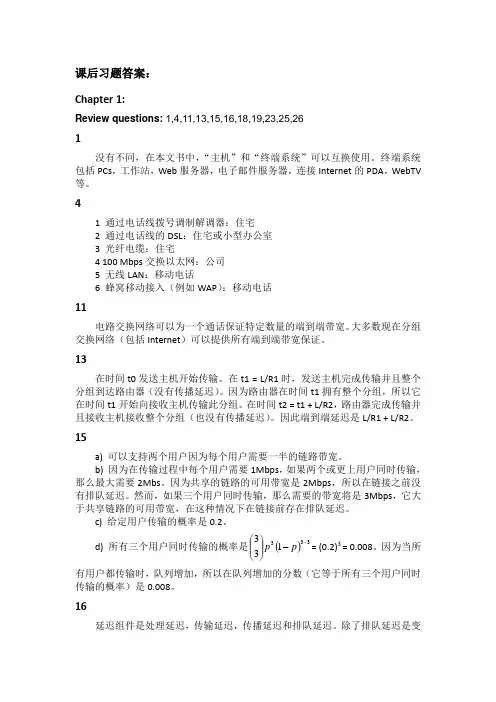
课后习题答案:Chapter 1:Review questions: 1,4,11,13,15,16,18,19,23,25,261没有不同,在本文书中,“主机”和“终端系统”可以互换使用。
终端系统包括PCs ,工作站,Web 服务器,电子邮件服务器,连接Internet 的PDA ,WebTV 等。
41 通过电话线拨号调制解调器:住宅2 通过电话线的DSL :住宅或小型办公室3 光纤电缆:住宅4 100 Mbps 交换以太网:公司5 无线LAN :移动电话6 蜂窝移动接入(例如WAP ):移动电话11电路交换网络可以为一个通话保证特定数量的端到端带宽。
大多数现在分组交换网络(包括Internet )可以提供所有端到端带宽保证。
13在时间t0发送主机开始传输。
在t1 = L/R1时,发送主机完成传输并且整个分组到达路由器(没有传播延迟)。
因为路由器在时间t1拥有整个分组,所以它在时间t1开始向接收主机传输此分组。
在时间t2 = t1 + L/R2,路由器完成传输并且接收主机接收整个分组(也没有传播延迟)。
因此端到端延迟是L/R1 + L/R2。
15a) 可以支持两个用户因为每个用户需要一半的链路带宽。
b) 因为在传输过程中每个用户需要1Mbps ,如果两个或更上用户同时传输,那么最大需要2Mbs 。
因为共享的链路的可用带宽是2Mbps ,所以在链接之前没有排队延迟。
然而,如果三个用户同时传输,那么需要的带宽将是3Mbps ,它大于共享链路的可用带宽,在这种情况下在链接前存在排队延迟。
c) 给定用户传输的概率是0.2。
d) 所有三个用户同时传输的概率是()333133--⎪⎪⎭⎫ ⎝⎛p p = (0.2)3 = 0.008。
因为当所有用户都传输时,队列增加,所以在队列增加的分数(它等于所有三个用户同时传输的概率)是0.008。
16延迟组件是处理延迟,传输延迟,传播延迟和排队延迟。
除了排队延迟是变化的,其它所有延迟都是固定的。
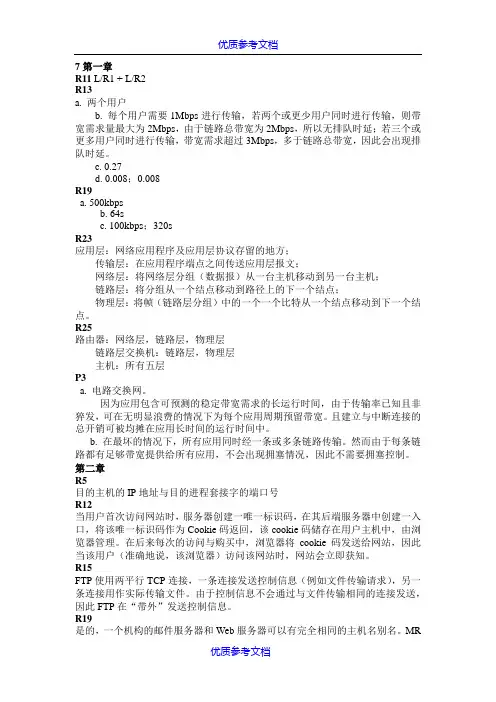
7第一章R11 L/R1 + L/R2R13a. 两个用户b. 每个用户需要1Mbps进行传输,若两个或更少用户同时进行传输,则带宽需求量最大为2Mbps,由于链路总带宽为2Mbps,所以无排队时延;若三个或更多用户同时进行传输,带宽需求超过3Mbps,多于链路总带宽,因此会出现排队时延。
c. 0.27d. 0.008;0.008R19a. 500kbpsb. 64sc. 100kbps;320sR23应用层:网络应用程序及应用层协议存留的地方;传输层:在应用程序端点之间传送应用层报文;网络层:将网络层分组(数据报)从一台主机移动到另一台主机;链路层:将分组从一个结点移动到路径上的下一个结点;物理层:将帧(链路层分组)中的一个一个比特从一个结点移动到下一个结点。
R25路由器:网络层,链路层,物理层链路层交换机:链路层,物理层主机:所有五层P3a. 电路交换网。
因为应用包含可预测的稳定带宽需求的长运行时间,由于传输率已知且非猝发,可在无明显浪费的情况下为每个应用周期预留带宽。
且建立与中断连接的总开销可被均摊在应用长时间的运行时间中。
b. 在最坏的情况下,所有应用同时经一条或多条链路传输。
然而由于每条链路都有足够带宽提供给所有应用,不会出现拥塞情况,因此不需要拥塞控制。
第二章R5目的主机的IP地址与目的进程套接字的端口号R12当用户首次访问网站时,服务器创建一唯一标识码,在其后端服务器中创建一入口,将该唯一标识码作为Cookie码返回,该cookie码储存在用户主机中,由浏览器管理。
在后来每次的访问与购买中,浏览器将cookie码发送给网站,因此当该用户(准确地说,该浏览器)访问该网站时,网站会立即获知。
R15FTP使用两平行TCP连接,一条连接发送控制信息(例如文件传输请求),另一条连接用作实际传输文件。
由于控制信息不会通过与文件传输相同的连接发送,因此FTP在“带外”发送控制信息。
R19是的,一个机构的邮件服务器和Web服务器可以有完全相同的主机名别名。
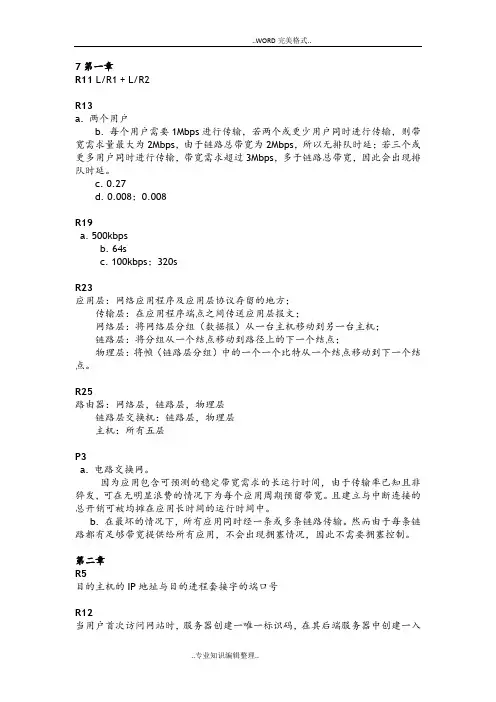
7第一章R11 L/R1 + L/R2R13a. 两个用户b. 每个用户需要1Mbps进行传输,若两个或更少用户同时进行传输,则带宽需求量最大为2Mbps,由于链路总带宽为2Mbps,所以无排队时延;若三个或更多用户同时进行传输,带宽需求超过3Mbps,多于链路总带宽,因此会出现排队时延。
c. 0.27d. 0.008;0.008R19a. 500kbpsb. 64sc. 100kbps;320sR23应用层:网络应用程序及应用层协议存留的地方;传输层:在应用程序端点之间传送应用层报文;网络层:将网络层分组(数据报)从一台主机移动到另一台主机;链路层:将分组从一个结点移动到路径上的下一个结点;物理层:将帧(链路层分组)中的一个一个比特从一个结点移动到下一个结点。
R25路由器:网络层,链路层,物理层链路层交换机:链路层,物理层主机:所有五层P3a. 电路交换网。
因为应用包含可预测的稳定带宽需求的长运行时间,由于传输率已知且非猝发,可在无明显浪费的情况下为每个应用周期预留带宽。
且建立与中断连接的总开销可被均摊在应用长时间的运行时间中。
b. 在最坏的情况下,所有应用同时经一条或多条链路传输。
然而由于每条链路都有足够带宽提供给所有应用,不会出现拥塞情况,因此不需要拥塞控制。
第二章R5目的主机的IP地址与目的进程套接字的端口号R12当用户首次访问网站时,服务器创建一唯一标识码,在其后端服务器中创建一入口,将该唯一标识码作为Cookie 码返回,该cookie 码储存在用户主机中,由浏览器管理。
在后来每次的访问与购买中,浏览器将cookie 码发送给网站,因此当该用户(准确地说,该浏览器)访问该网站时,网站会立即获知。
R15FTP 使用两平行TCP 连接,一条连接发送控制信息(例如文件传输请求),另一条连接用作实际传输文件。
由于控制信息不会通过与文件传输相同的连接发送,因此FTP 在“带外”发送控制信息。
R19是的,一个机构的邮件服务器和Web 服务器可以有完全相同的主机名别名。
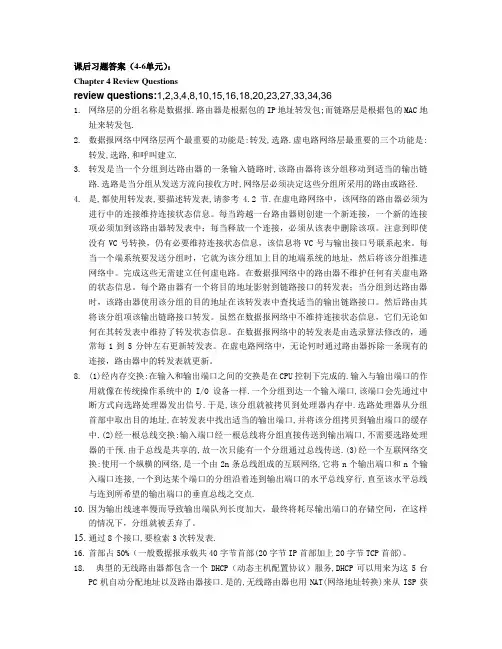
课后习题答案(4-6单元):Chapter 4 Review Questionsreview questions:1,2,3,4,8,10,15,16,18,20,23,27,33,34,361.网络层的分组名称是数据报.路由器是根据包的IP地址转发包;而链路层是根据包的MAC地址来转发包.2.数据报网络中网络层两个最重要的功能是:转发,选路.虚电路网络层最重要的三个功能是:转发,选路,和呼叫建立.3.转发是当一个分组到达路由器的一条输入链路时,该路由器将该分组移动到适当的输出链路.选路是当分组从发送方流向接收方时,网络层必须决定这些分组所采用的路由或路径.4.是,都使用转发表,要描述转发表,请参考4.2节.在虚电路网络中,该网络的路由器必须为进行中的连接维持连接状态信息。
每当跨越一台路由器则创建一个新连接,一个新的连接项必须加到该路由器转发表中;每当释放一个连接,必须从该表中删除该项。
注意到即使没有VC号转换,仍有必要维持连接状态信息,该信息将VC号与输出接口号联系起来。
每当一个端系统要发送分组时,它就为该分组加上目的地端系统的地址,然后将该分组推进网络中。
完成这些无需建立任何虚电路。
在数据报网络中的路由器不维护任何有关虚电路的状态信息。
每个路由器有一个将目的地址影射到链路接口的转发表;当分组到达路由器时,该路由器使用该分组的目的地址在该转发表中查找适当的输出链路接口。
然后路由其将该分组项该输出链路接口转发。
虽然在数据报网络中不维持连接状态信息,它们无论如何在其转发表中维持了转发状态信息。
在数据报网络中的转发表是由选录算法修改的,通常每1到5分钟左右更新转发表。
在虚电路网络中,无论何时通过路由器拆除一条现有的连接,路由器中的转发表就更新。
8.(1)经内存交换:在输入和输出端口之间的交换是在CPU控制下完成的.输入与输出端口的作用就像在传统操作系统中的I/O设备一样.一个分组到达一个输入端口,该端口会先通过中断方式向选路处理器发出信号.于是,该分组就被拷贝到处理器内存中.选路处理器从分组首部中取出目的地址,在转发表中找出适当的输出端口,并将该分组拷贝到输出端口的缓存中.(2)经一根总线交换:输入端口经一根总线将分组直接传送到输出端口,不需要选路处理器的干预.由于总线是共享的,故一次只能有一个分组通过总线传送.(3)经一个互联网络交换:使用一个纵横的网络,是一个由2n条总线组成的互联网络,它将n个输出端口和n个输入端口连接,一个到达某个端口的分组沿着连到输出端口的水平总线穿行,直至该水平总线与连到所希望的输出端口的垂直总线之交点.10.因为输出线速率慢而导致输出端队列长度加大,最终将耗尽输出端口的存储空间,在这样的情况下,分组就被丢弃了。
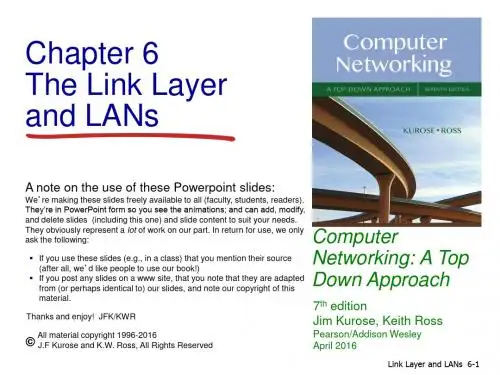
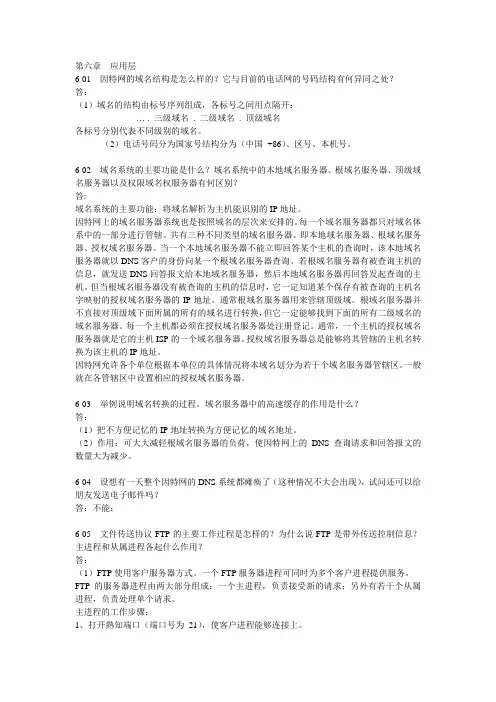
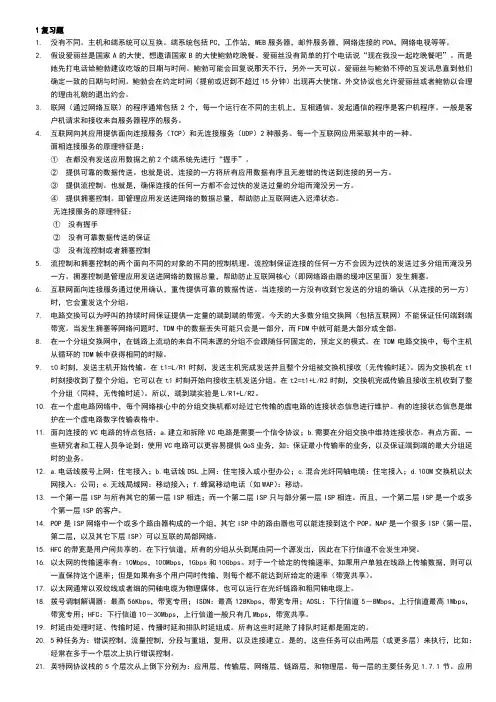
1复习题1.没有不同。
主机和端系统可以互换。
端系统包括PC,工作站,WEB服务器,邮件服务器,网络连接的PDA,网络电视等等。
2.假设爱丽丝是国家A的大使,想邀请国家B的大使鲍勃吃晚餐。
爱丽丝没有简单的打个电话说“现在我没一起吃晚餐吧”。
而是她先打电话给鲍勃建议吃饭的日期与时间。
鲍勃可能会回复说那天不行,另外一天可以。
爱丽丝与鲍勃不停的互发讯息直到他们确定一致的日期与时间。
鲍勃会在约定时间(提前或迟到不超过15分钟)出现再大使馆。
外交协议也允许爱丽丝或者鲍勃以合理的理由礼貌的退出约会。
3.联网(通过网络互联)的程序通常包括2个,每一个运行在不同的主机上,互相通信。
发起通信的程序是客户机程序。
一般是客户机请求和接收来自服务器程序的服务。
4.互联网向其应用提供面向连接服务(TCP)和无连接服务(UDP)2种服务。
每一个互联网应用采取其中的一种。
面相连接服务的原理特征是:①在都没有发送应用数据之前2个端系统先进行“握手”。
②提供可靠的数据传送。
也就是说,连接的一方将所有应用数据有序且无差错的传送到连接的另一方。
③提供流控制。
也就是,确保连接的任何一方都不会过快的发送过量的分组而淹没另一方。
④提供拥塞控制。
即管理应用发送进网络的数据总量,帮助防止互联网进入迟滞状态。
无连接服务的原理特征:①没有握手②没有可靠数据传送的保证③没有流控制或者拥塞控制5.流控制和拥塞控制的两个面向不同的对象的不同的控制机理。
流控制保证连接的任何一方不会因为过快的发送过多分组而淹没另一方。
拥塞控制是管理应用发送进网络的数据总量,帮助防止互联网核心(即网络路由器的缓冲区里面)发生拥塞。
6.互联网面向连接服务通过使用确认,重传提供可靠的数据传送。
当连接的一方没有收到它发送的分组的确认(从连接的另一方)时,它会重发这个分组。
7.电路交换可以为呼叫的持续时间保证提供一定量的端到端的带宽。
今天的大多数分组交换网(包括互联网)不能保证任何端到端带宽。
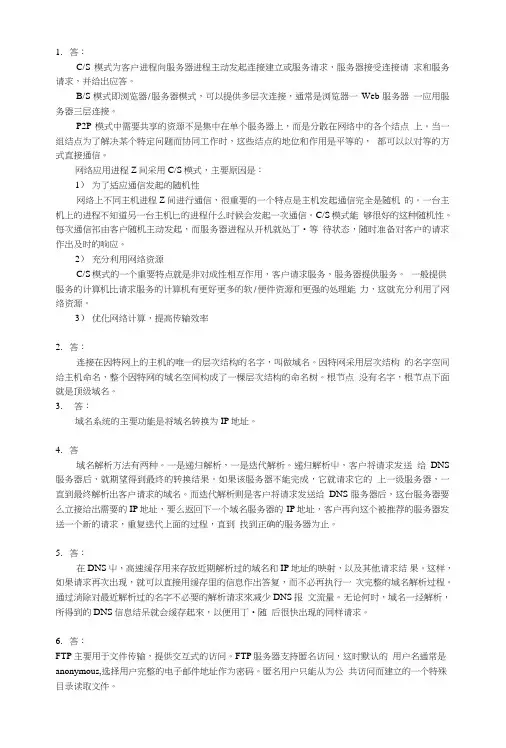
1.答:C/S模式为客户进程向服务器进程主动发起连接建立或服务请求,服务器接受连接请求和服务请求,并给出应答。
B/S模式即浏览器/服务器模式,可以提供多层次连接,通常是浏览器一Web服务器一应用服务器三层连接。
P2P模式中需要共享的资源不是集中在单个服务器上,而是分散在网络中的各个结点上。
当一组结点为了解决某个特定问题而协同工作时,这些结点的地位和作用是平等的,都可以以对等的方式直接通信。
网络应用进程Z间采用C/S模式,主要原因是:1)为了适应通信发起的随机性网络上不同主机进程Z间进行通信,很重要的一个特点是主机发起通信完全是随机的。
一台主机上的进程不知道另一台主机匕的进程什么时候会发起一次通信。
C/S模式能够很好的这种随机性。
每次通信祁由客户随机主动发起,而服务器进程从开机就处丁•等待状态,随时准备对客户的请求作岀及时的响应。
2)充分利用网络资源C/S模式的一个重要特点就是非对成性相互作用,客户请求服务,服务器提供服务。
一般提供服务的计算机比请求服务的计算机有更好更多的软/便件资源和更强的处理能力,这就充分利用了网络资源。
3)优化网络计算,提高传输效率2.答:连接在因特网上的主机的唯一的层次结构的名字,叫做域名。
因特网采用层次结构的名字空间给主机命名,整个因特网的域名空间构成了一棵层次结构的命名树。
根节点没有名字,根节点下面就是顶级域名。
3.答:域名系统的主要功能是将域名转换为IP地址。
4.答域名解析方法有两种。
一是递归解析,一是迭代解析。
递归解析屮,客户将请求发送给DNS 服务器后,就期望得到最终的转换结果。
如果该服务器不能完成,它就请求它的上一级服务器,一直到最终解析出客户请求的域名。
而迭代解析则是客户将请求发送给DNS服务器后,这台服务器要么立接给出需要的IP地址,要么返回下一个域名服务器的IP地址,客户再向这个被推荐的服务器发送一个新的请求,重复迭代上面的过程,直到找到正确的服务器为止。

6复习题1.APs周期性的发送信标帧,AP的一个信标帧通过11个信道中的一个发送。
信标帧允许附近的无线基站发现和识别AP。
2.1)基于无线主机的MAC地址;2)用户名和密码的结合。
在这2中情况中,AP把信息传送给认证服务器。
3.不对4.2个原因:1)无线信道中误码率比较高;2)在有线的以太网中,发送站点能够检测到是否有碰撞发生,然而在802.11中站点不能检测到碰撞。
5.不对6.每一个无线基站都可以设置一个RTS阈值,因此只有当将要传送的数据帧长度长于这个阈值时,RTS/CTS序列才会被用到。
7.没有好处。
假设有2个站点同时想发送数据,并且他们都使用RTS/CTS。
如果RTS/CTS的帧长和数据帧长一样时,信道就会被浪费,因为发送RTS/CTS的时间和发送数据的时间一样。
因此RTS/CTS交换只有当RTS/CTS 帧长远小于数据帧长时才有用。
8.开始时,交换机在其转发表中有一个表项标识了无线站点和前一个AP的联系。
当无线基站和新的AP联系时,新的AP将创建一个包括无线基站MAC地址以及以太网广播帧的帧。
当交换机收到该帧时,更新其转发表,使得无线站点可以通过新的AP到达。
9.UMTS源于GSM,CDMA200源于IS-95。
习题1.输出d1 = [-1,1,-1,1,-1,1,-1,1];d0 = [1,-1,1,-1,1,-1,1,-1]2.发送方2的输出= [1,-1,1,1,1,-1,1,1]; [ 1,-1,1,1,1,-1,1,1]3.4.a)两个AP有不同的SSID和MAC地址。
一个到达咖啡馆的无线站点将会和其中一个AP的联系。
发生联系后,在新的站点和AP之间会建立一条虚链路。
把两个ISP的AP标识为AP1和AP2。
假设新的站点和AP1相关联。
当它发送一个帧的时候,它将会到达AP1。
虽然AP2也会收到这个帧,但是它不会处理这个帧,因为这个帧发送给它的。
因此这两个ISP能在相同的信道上平行地工作。
全国自学考试计算机网络管理第六章真题及答案(含页码)2008.012007.1010.Window Server 2003远程管理功能的改进中,与Window Server 2000中终端服务对应的是(C )P169A.远程协助B.远程管理的Web界面C.管理远程桌面D.远程安装服务2007.0111.Windows 2003 Server的活动目录所命名方式是( D )P159A.文件命名B.数字命名C.用户自定义D.DNS17.在Windows Server 2003环境中,仅用于分发电子邮件且没有启用安全性的组类型是(C )P157A.安全组B.全局组C.通信组D.本地组2006.109.在用户模式中使用Microsoft管理控制台MMC的方法是( A )P170A.使用已有的MMC B.创建新的MMC C.修改已有的MMC D.定期更新MMC 18.Windows Server 2003活动目录优越性中,使得网络对象组织良好、更易于定位信息的是( B )P159A.高伸缩性B.集中的管理C.整合DNS D.委派授权二、填空题(本大题共10小题,每小题1分,共10分)2012.0130.使用Microsoft管理控制台MMC有两种方法,一种是在用户模式中使用已有的MMC,另一种是在_作者模式_____中,创建新的MMC或修改已有的MMC。
P1702011.1029.在Windows Server 2003中,新建用户组时可以设置的组类型有:安全组和__通信组_。
P157P age 6 of 122011.0129.在Windows Server 2003家族中,_活动目录___ 允许对网络打印机、用户等资源和桌面、服务和应用程序等进行中央管理。
P1592010.1029.Windows Server 2003的终端服务基本由三部分技术组成,即__客户端部分_、协议部分及服务器部分。
P1642010.0130.终端服务基本由三部分技术组成,即客户端部分、____协议部分_和服务器部分。
6复习题
1.APs周期性的发送信标帧,AP的一个信标帧通过11个信道中的一个发送。
信标帧允许附近的无线基站发现和
识别AP。
2.1)基于无线主机的MAC地址;2)用户名和密码的结合。
在这2中情况中,AP把信息传送给认证服务器。
3.不对
4.2个原因:1)无线信道中误码率比较高;2)在有线的以太网中,发送站点能够检测到是否有碰撞发生,然而
在802.11中站点不能检测到碰撞。
5.不对
6.每一个无线基站都可以设置一个RTS阈值,因此只有当将要传送的数据帧长度长于这个阈值时,RTS/CTS序列
才会被用到。
7.没有好处。
假设有2个站点同时想发送数据,并且他们都使用RTS/CTS。
如果RTS/CTS的帧长和数据帧长一样
时,信道就会被浪费,因为发送RTS/CTS的时间和发送数据的时间一样。
因此RTS/CTS交换只有当RTS/CTS 帧长远小于数据帧长时才有用。
8.开始时,交换机在其转发表中有一个表项标识了无线站点和前一个AP的联系。
当无线基站和新的AP联系时,
新的AP将创建一个包括无线基站MAC地址以及以太网广播帧的帧。
当交换机收到该帧时,更新其转发表,使得无线站点可以通过新的AP到达。
9.UMTS源于GSM,CDMA200源于IS-95。
习题
1.输出d1 = [-1,1,-1,1,-1,1,-1,1];d0 = [1,-1,1,-1,1,-1,1,-1]
2.发送方2的输出= [1,-1,1,1,1,-1,1,1]; [ 1,-1,1,1,1,-1,1,1]
3.
4.a)两个AP有不同的SSID和MAC地址。
一个到达咖啡馆的无线站点将会和其中一个AP的联系。
发生联系后,
在新的站点和AP之间会建立一条虚链路。
把两个ISP的AP标识为AP1和AP2。
假设新的站点和AP1相关联。
当它发送一个帧的时候,它将会到达AP1。
虽然AP2也会收到这个帧,但是它不会处理这个帧,因为这个帧发送给它的。
因此这两个ISP能在相同的信道上平行地工作。
尽管如此,这两个ISP将共享相同的无线带宽。
如果不同的ISP中的无线站点同时发送数据,将会产生碰撞。
对802.11b来说,两个ISP的最大合计传输速率为Mbps。
b)现在如果不同的ISP中的2个无线终端同时发送数据,就不会产生碰撞。
因此这2个ISP的最大合计传输速率为22Mbps对802.11b来说。
5.这样设计是为了公平。
我们假设开始只有H1这一个无线站点发送数据,当时当H1发送到一半时,另一个站点
H2也要发送一个帧,为了简单起见,我们还是假设没有隐藏的终端。
在发送之前,H2检测到信道忙,因此它要选择一个随机的回退值。
现在我们假设H1发送完第一个帧以后,如果退回到第一步,即它等待一个DIFS然后发送第二个帧。
那么H2仍将被阻塞并再次等待信道的空闲时刻。
因此,如果H1有1000个帧要传的话,那么H2只有等H1传完这1000个帧後才能有机会接入这个信道。
但是如果H1传完第一个帧後退回到第二步,那么它也将选取一个随机的回退值,这样的话就给了H2发送数据的机会。
6.不含有数据的帧长为32字节。
假设传输速率是11 Mbps,传输一个控制帧的时间为32*8/11 Mbps=23usec.传输
数据帧所需的时间为(8256 bits)/(11 Mbps) = 751usec。
总时间为:
DIFS + RTS + SIFS + CTS + SIFS + FRAME + SIFS + ACK= DIFS + 3SIFS + (3*23 + 751) usec = DIFS + 3SIFS + 820 usec。
7.a)不会。
因为在距离矢量算法中,目的点的改变信息只会在相邻的节点间传输(这不同于链路状态路由,在这
个算法中,信息的改变将会通过广播发送到所有的路由器,因此在链路状态广播后,所有的路由器将会知道网
络中的变化)。
b) 在距离矢量算法中,不同的路由器对移动节点访问的网络有不同的认识。
路由器不会知道被访问网络的变化,
除非信息通过发生在到移动节点的路由器间的一对路由信息的交换传送给它。
c)时间范围和网络的直径(源到目的地的最长距离)的概念相似。
因为路由信息只会通过路径上的相邻路由器信息的成对的交换传播。
因此在最坏的情况下,从网络中一点到另一点传播信息所需要的时间决定与网络的直径。
8.如果通信者是移动的,那么任何到达它的数据报都会经过它的归属代理。
网络中的正在被访问的外部代理也和
这个过程有关,因为外部代理向通信者的归属代理通报了通信者的位置。
通信者的归属代理接收到的数据报将会被封装并在通信者的归属代理与外部代理之间传送。
9.因为数据报必须先传到归属代理,然后从归属代理再传到移动站点,这样的话时延就会比直接路由时的时延大。
注意到从通信者到移动站点的直接时延实际上可能比从通信者到归属代理再到移动站点这个过程的总时延要小。
它还决定于不同路径段的时延。
注意到间接路由也会引入一个归属代理处理时延。
10.
11.可以有相同的转交地址。
如果转交地址就是外部代理的地址的话,这个地址就是相同的。
一旦外部代理拆封了
隧道数据报(tunneled datagram)并确定了移动节点的地址,那么分离的地址就要单独传送数据报到它们在这个被访问网络中不同的目的地。
12.如果MSRN被提供给HLR,那么,一旦MSRN发生改变,它的值在HLR中必须更新。
在HLR中提供MSRN的
好处是它的值能够被迅速地提供,而不用去询问VLR。